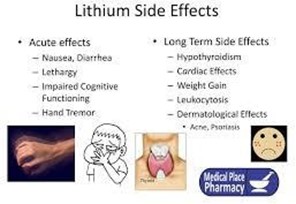The nurse is admitting a male client who takes lithium carbonate twice a day. Which information should the nurse report to the healthcare provider immediately?

Five-pound (2.3 kg) weight gain.
Nausea and vomiting.
Short-term memory loss.
Depressed affect.
The Correct Answer is B
Choice A rationale:
A five-pound weight gain in a client taking lithium carbonate is significant. however, the timeframe of the weightgain is to be known. Choice B rationale:
Nausea and vomiting are known side effects of lithium that should be reported as they can cause electrolyte imbalance.
Choice C rationale:
Short-term memory loss is a potential side effect of lithium, but it may not require immediate reporting unless it significantly affects the client's daily functioning or is associated with other concerning symptoms.
Choice D rationale:
A depressed affect is a symptom that should be addressed as part of the client's ongoing psychiatric care, but it may not warrant immediate reporting unless it is severe and requires a change in the treatment plan. The priority in this case is the potential lithium toxicity indicated by the weight gain.
Nursing Test Bank
Naxlex Comprehensive Predictor Exams
Related Questions
Correct Answer is D
Explanation
Choice A rationale:
An adult with schizophrenia who often refuses to take prescribed antipsychotic medications may require a different approach, such as medication education or supportive therapy.
Choice B rationale:
A hyperactive 4-year-old who has recently been tested for autism may benefit from play therapy or other age-appropriate interventions rather than role-playing.
Choice C rationale:
An older adult resident of a long-term care facility who sometimes takes other residents' belongings may require interventions focused on behavior management and addressing the underlying causes of this behavior.
Choice D rationale:
Role-playing can be an effective therapeutic intervention for individuals who need to practice social skills, communication, and problem-solving in a safe and controlled environment. In this case, the adolescent who is depressed over not being accepted by peers may benefit from role-playing to develop and practice social skills, assertiveness, and coping strategies for peer interactions.
Correct Answer is ["B","D","E"]
Explanation
Choice A rationale:
Restricting visitors to family members only may not necessarily be a beneficial intervention and could potentially isolate the client further, which may not be in their best interest.
Choice B rationale:
Discussing the client's suicide plan is essential to assess the level of risk and develop strategies to keep the client safe. It allows the healthcare team to understand the severity of the client's depressive symptoms and potential suicidal ideation.
Choice C rationale:
Limiting the time allowed to play video games may be a consideration in a broader plan of care, but it is not a primary intervention for addressing depression in adolescents. The focus should be on safety, communication, and building a therapeutic relationship.
Choice D rationale:
Encouraging the client to discuss thoughts and feelings about wanting to die is crucial for therapeutic communication and assessment. It provides an opportunity for the client to express their emotions and allows for intervention and support.
Choice E rationale:
Reinforcing statements regarding a will to live and realistic plans for the future is important for building hope and motivation in the client. It can be part of a positive, strengths-based approach to treatment.
Whether you are a student looking to ace your exams or a practicing nurse seeking to enhance your expertise , our nursing education contents will empower you with the confidence and competence to make a difference in the lives of patients and become a respected leader in the healthcare field.
Visit Naxlex, invest in your future and unlock endless possibilities with our unparalleled nursing education contents today
Report Wrong Answer on the Current Question
Do you disagree with the answer? If yes, what is your expected answer? Explain.
Kindly be descriptive with the issue you are facing.
